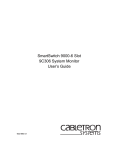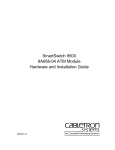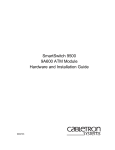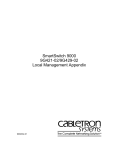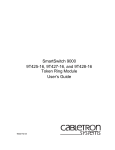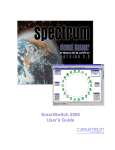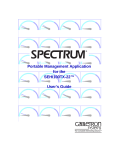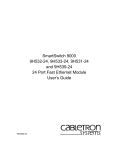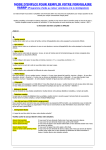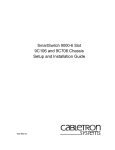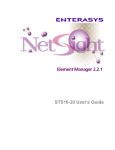Download Cabletron Systems 9C214-3 User`s guide
Transcript
SmartSwitch 9000 9G421-02/9G429-02 Gigabit Ethernet Interface Module User’s Guide 9032344-02 Notice Notice Cabletron Systems reserves the right to make changes in speciÞcations and other information contained in this document without prior notice. The reader should in all cases consult Cabletron Systems to determine whether any such changes have been made. The hardware, Þrmware, or software described in this manual is subject to change without notice. IN NO EVENT SHALL CABLETRON SYSTEMS BE LIABLE FOR ANY INCIDENTAL, INDIRECT, SPECIAL, OR CONSEQUENTIAL DAMAGES WHATSOEVER (INCLUDING BUT NOT LIMITED TO LOST PROFITS) ARISING OUT OF OR RELATED TO THIS MANUAL OR THE INFORMATION CONTAINED IN IT, EVEN IF CABLETRON SYSTEMS HAS BEEN ADVISED OF, KNOWN, OR SHOULD HAVE KNOWN, THE POSSIBILITY OF SUCH DAMAGES. © July 1999 by: Cabletron Systems, Inc. 35 Industrial Way Rochester, NH 03867-5005 All Rights Reserved Printed in the United States of America Order Number: 9032344-02 Cabletron Systems and LANVIEW are registered trademarks, and SmartSwitch is a trademark of Cabletron Systems, Inc. CompuServe is a registered trademark of CompuServe, Inc. i960 microprocessor is a registered trademark of Intel Corp. Ethernet is a trademark of Xerox Corporation. All other product names mentioned in this manual may be trademarks or registered trademarks of their respective companies. i Notice FCC Notice This device complies with Part 15 of the FCC rules. Operation is subject to the following two conditions: (1) this device may not cause harmful interference, and (2) this device must accept any interference received, including interference that may cause undesired operation. NOTE: This equipment has been tested and found to comply with the limits for a Class A digital device, pursuant to Part 15 of the FCC rules. These limits are designed to provide reasonable protection against harmful interference when the equipment is operated in a commercial environment. This equipment uses, generates, and can radiate radio frequency energy and if not installed in accordance with the operatorÕs manual, may cause harmful interference to radio communications. Operation of this equipment in a residential area is likely to cause interference in which case the user will be required to correct the interference at his own expense. WARNING: Changes or modiÞcations made to this device which are not expressly approved by the party responsible for compliance could void the userÕs authority to operate the equipment. Industry Canada Notice This digital apparatus does not exceed the Class A limits for radio noise emissions from digital apparatus set out in the Radio Interference Regulations of the Canadian Department of Communications. Le prŽsent appareil numŽrique nÕŽmet pas de bruits radioŽlectriques dŽpassant les limites applicables aux appareils numŽriques de la class A prescrites dans le R•glement sur le brouillage radioŽlectrique ŽdictŽ par le minist•re des Communications du Canada. VCCI Notice This is a Class A product based on the standard of the Voluntary Control Council for Interference by Information Technology Equipment (VCCI). If this equipment is used in a domestic environment, radio disturbance may arise. When such trouble occurs, the user may be required to take corrective actions. ii Notice Safety Information CLASS 1 LASER TRANSCEIVERS The 9G429-02 is a Class 1 Laser Product The 9G429-02 uses a Class 1 Laser transceiver. Read the following safety information before installing or operating these adapters. The Class 1 laser transceivers use an optical feedback loop to maintain Class 1 operation limits. This control loop eliminates the need for maintenance checks or adjustments. The output is factory set, and does not allow any user adjustment. Class 1 Laser transceivers comply with the following safety standards: ¥ 21 CFR 1040.10 and 1040.11 U.S. Department of Health and Human Services (FDA). ¥ IEC Publication 825 (International Electrotechnical Commission). ¥ CENELEC EN 60825 (European Committee for Electrotechnical Standardization). When operating within their performance limitations, laser transceiver output meets the Class 1 accessible emission limit of all three standards. Class 1 levels of laser radiation are not considered hazardous. Laser Radiation and Connectors When the connector is in place, all laser radiation remains within the Þber. The maximum amount of radiant power exiting the Þber (under normal conditions) is -12.6 dBm or 55 x 10-6 watts. Removing the optical connector from the transceiver allows laser radiation to emit directly from the optical port. The maximum radiance from the optical port (under worst case conditions) is 0.8 W cm-2 or 8 x 103 W m2 sr-1. Do not use optical instruments to view the laser output. The use of optical instruments to view laser output increases eye hazard. When viewing the output optical port, power must be removed from the network adapter. iii Notice Declaration of Conformity Addendum Application of Council Directive(s): ManufacturerÕs Name: ManufacturerÕs Address: European Representative Name: European Representative Address: Conformance to Directive(s)/Product Standards: Equipment Type/Environment: 89/336/EEC 73/23/EEC Cabletron Systems, Inc. 35 Industrial Way PO Box 5005 Rochester, NH 03867 Mr. J. Solari Cabletron Systems Limited Nexus House, Newbury Business Park London Road, Newbury Berkshire RG14 2PZ, England EC Directive 89/336/EEC EC Directive 73/23/EEC EN 55022 EN 50082-1 EN 60950 Networking Equipment, for use in a Commercial or Light Industrial Environment. We the undersigned, hereby declare, under our sole responsibility, that the equipment packaged with this notice conforms to the above directives. Manufacturer Legal Representative in Europe Mr. Ronald Fotino ____________________________________________________ Full Name Mr. J. Solari ______________________________________________________ Compliance Engineer Manager ____________________________________________________ Title Managing Director - E.M.E.A. ______________________________________________________ Rochester, NH, USA ____________________________________________________ Location Newbury, Berkshire, England ______________________________________________________ iv Full Name Title Location Contents Contents Chapter 1 Introduction Features........................................................................................................................... 1-3 Related Manuals............................................................................................................ 1-4 Getting Help .................................................................................................................. 1-5 Chapter 2 Installation Tools Needed ................................................................................................................. 2-1 Unpacking the Module................................................................................................. 2-1 Physical Layout ............................................................................................................. 2-2 User Accessible Daughterboard Components .......................................................... 2-3 DIP Switch............................................................................................................... 2-3 Removing the Daughterboard from the Motherboard..................................... 2-5 Daughterboard Components ............................................................................... 2-7 SMB-1 PROM .................................................................................................. 2-7 BOOT PROM ................................................................................................... 2-7 FLASH SIMM.................................................................................................. 2-7 DRAM SIMM .................................................................................................. 2-7 Installing the Module into the SmartSwitch 9000 Chassis...................................... 2-8 The Reset Switch ......................................................................................................... 2-10 Chapter 3 Operation System Management Buses ......................................................................................... 3-2 SMB-1 Bus ............................................................................................................... 3-2 SMB-10 Bus ............................................................................................................. 3-2 System Diagnostic Controller...................................................................................... 3-2 DC/DC Converter ........................................................................................................ 3-3 INB Interface.................................................................................................................. 3-3 SecureFast SmartSwitch Architecture ........................................................................ 3-3 i960 Core......................................................................................................................... 3-4 v Contents Chapter 4 LANVIEW LEDs Appendix A Specifications Technical SpeciÞcations ...............................................................................................A-1 CPU .........................................................................................................................A-1 Memory ..................................................................................................................A-1 Network Interfaces ...............................................................................................A-1 Regulatory Compliance...............................................................................................A-2 Service ............................................................................................................................A-2 Physical ..........................................................................................................................A-3 Dimensions ............................................................................................................A-3 Weight .....................................................................................................................A-3 Environment ..........................................................................................................A-3 vi Chapter 1 Introduction The 9G421-02/9G429-02 (Figure 1-1) is a Gigabit Ethernet interface module, occupying a single slot in the SmartSwitch 9000 chassis. Gigabit Ethernet networks are connected to the 9G421-02/9G429-02 through front panel ports. These ports interface with the switch through Gigabit Network Interface Blocks (GNIB) and are based upon an ASIC architecture. The module connects to the Internal Network Bus (INB) B, providing a high speed backplane for communication among other modules in the SmartSwitch 9000 chassis. The 9G421-02/9G429-02 uses a SmartSwitch ASIC design and an advanced Intel i960¨ microprocessor providing a platform for all management functions within a scalable RISC-Based Architecture. Network management information is available through a variety of methods. All information based on Simple Network Management Protocol (SNMP) is accessible either via an in-band (Front Panel port), Side Band (SMB-10), or via the Environmental ModuleÕs (EM) COM ports. Serial Line Internet Protocol (SLIP) or Point-to-Point Protocol (PPP) is supported by the EM COM ports. For more information on the SMB-10, SLIP or PPP refer to the SmartSwitch 9000 Local Management UserÕs Guide. The 9G421-02/9G429-02 features front panel LANVIEW¨ Diagnostic LEDs to offer at-a-glance status information about each front panel port as well as the operation of the overall module. ! CAUTION The 9G421-02 uses a shortwave 850 nanometer laser. The 9G429-02 uses a longwave 1300 nanometer laser. Follow applicable safety precautions to prevent injury. 1-1 Introduction SMB CPU INB E N E T 1 E N E T 2 Figure 1-1. The 9G421-02/9G429-02 Module 1-2 Introduction Features Processor The 9G421-02/9G429-02 is equipped with an advanced Intel i960 microprocessor. This microprocessor provides a platform for all management functions, such as Spanning Tree, RMON, and MIB support within a scalable RISC-Based architecture. Fast Packet Switching The 9G421-02/9G429-02 incorporates a hardware-based switch design referred to as the SmartSwitch ASIC, a collection of custom ASICs designed speciÞcally for high-speed switching. Management The 9G421-02/9G429-02 features SNMP for local and remote management. Local management is provided through the RS232 COM ports on the SmartSwitch 9000 Environmental Module using a standard VT220 terminal or emulator. Remote management is possible through CabletronÕs SPECTRUM or any SNMPcompliant management tool. Included as management features are the IETF Standard Management Information Base (MIBs) RMON (RFC 1271), IETF MIB II (RFC 1213), IETF Bridge MIB (RFC 1493), and a host of other Cabletron enterprise MIBs. The 9G421-02/9G429-02 also offers the user a wide variety of statistical network management information to enhance network planning and troubleshooting. This module provides information for each front panel Ethernet Gigabit port, including packet counts along with errored frame information, such as collisions, CRCs, and Giants, via a variety of industry-standard and private MIBs. Industry standard IEEE 802.1d bridging, including the Spanning Tree Algorithm, is supported. Connectivity The 9G421-02 has one interface to the INB and two front panel multimode Þber (MMF) cables connecting to SC connectors. The INB interface is a Þxed connection to the INB, allowing the 9G421-02 to communicate with other SmartSwitch 9000 modules supporting various LAN technologies including Token Ring, FDDI, Ethernet, WAN and ATM. Each front panel SC connector provides 1 Ethernet Gigabit connection. The 9G429-02 has one interface to the INB-B and two single mode Þber (SMF)/MMF SC connectors on the front panel of the module. 1-3 Introduction Management Information Base (MIB) Support The 9G421-02/9G429-02 provides MIB support including ¥ ¥ ¥ RMON (RFC 1271) IETF MIB II (RFC 1213) IETF Bridge MIB (RFC 1493) and a host of other Cabletron Enterprise MIBs. NOTE For a complete list of supported MIBs, refer to the release notes provided in the 9G421-02/9G429-02 package. LANVIEW LEDs The 9G421-02/9G429-02 uses LANVIEW¨, the Cabletron Systems built-in visual diagnostic and status monitoring system. With LANVIEW LEDs you can quickly identify system status, as well as the device, port, and physical layer status. Two LEDs indicate the transmission and reception of data from the INB SmartSwitch 9000 backplane connection. Each of the two Ethernet front panel ports feature two LEDs per port indicating the portÕs Administrative status (enabled/disabled), LINK status (Link/No link), and Data Activity (receiving and transmitting data). Related Manuals The Cabletron Systems manuals listed below may supplement the procedures and technical data contained in this manual. ¥ ¥ ¥ ¥ ¥ ¥ ¥ 1-4 SmartSwitch 9000 Installation Guide SmartSwitch 9000 9C300-1 Environmental Module UserÕs Guide SmartSwitch 9000 9C214-1 AC Power Supply UserÕs Guide SmartSwitch 9000 Local Management UserÕs Guide INB Terminator Modules Installation Guide Ethernet Technology Guide Cabling Guide Introduction Getting Help For additional support related to this device or document, contact Cabletron Systems using one of the following methods: World Wide Web http://www.cabletron.com/ Phone (603) 332-9400 Internet mail [email protected] FTP ftp://ftp.cabletron.com/ anonymous your email address Login Password To send comments or suggestions concerning this document, contact the Cabletron Systems Technical Writing Department via the following email address: [email protected] Make sure to include the document Part Number in the email message. Before calling Cabletron Systems, have the following information ready: ¥ Your Cabletron Systems service contract number ¥ A description of the failure ¥ A description of any action(s) already taken to resolve the problem (e.g., changing mode switches, rebooting the unit, etc.) ¥ The serial and revision numbers of all involved Cabletron Systems products in the network ¥ A description of your network environment (layout, cable type, etc.) ¥ Network load and frame size at the time of trouble (if known) ¥ The device history (i.e., have you returned the device before, is this a recurring problem, etc.) ¥ Any previous Return Material Authorization (RMA) numbers 1-5 Introduction 1-6 Chapter 2 Installation This chapter describes the physical layout of the 9G421-02/9G429-02 module and explains preparation and installation procedures for use in a SmartSwitch 9000 chassis. The 9G421-02/9G429-02 occupies a single slot in the SmartSwitch 9000 chassis. Install the 9G421-02/9G429-02 by following the steps in Unpacking the Module below. Only qualiÞed personnel should perform installation procedures. ! CAUTION Never expose the moduleÕs components to Electrostatic Discharge. Make sure you have attached the moduleÕs disposable grounding strap to your wrist and always place the module on a non-conductive surface. Tools Needed ¥ NOTE Phillips screwdriver The INB Terminator modules must be installed on the rear of the chassis before powering up this module. Refer to the INB Terminator Modules Installation Guide for the installation procedure. The INB Terminator modules are essential to the proper operation of the bus on the chassis. Unpacking the Module 1. Carefully remove the module from the shipping box. (Save the box and packing materials in the event it must be reshipped.) 2. Remove the module from the plastic bag. Observe all precautions to prevent damage from Electrostatic Discharge (ESD). 3. Carefully examine the module, checking for damage. If any damage exists, DO NOT install the module. Contact Cabletron Systems immediately. 2-1 Installation Physical Layout The 9G421-02/9G429-02 has two major circuit boards on which components are attached (see Figure 2-1). The base-level circuit board is known as the motherboard and the second-level circuit board is known as the daughterboard. The removable daughterboard attaches to the motherboard with connectors and standoffs. Both the motherboard and the daughterboard contain components accessible to the user. Motherboard Daughterboard Figure 2-1. The 9G421-02/9G429-02 Circuit Boards 2-2 Installation User Accessible Daughterboard Components The user accessible components are located on the underside of the daughterboard. These components include an eight-position DIP switch, a replaceable SMB-1 PROM, a replaceable BOOT PROM, and sockets for DRAM and FLASH memory. You can access the DIP switch without removing the daughterboard. However, to access the other components on the daughterboard, you must remove the daughterboard from the motherboard. DIP Switch The daughterboard eight-position DIP switch location is shown in Figure 2-2. The switch functions are described in Table 2-1. N O DIP Switch (side view in insert) 12 3 4 5 6 7 8 Figure 2-2. 9G421-02/9G429-02 Daughterboard DIP Switch Location 2-3 Installation Table 2-1. Function of DIP Switch Switch Function 8 Clear Password 1 When toggled, this switch clears user-entered passwords stored in NVRAM, and restores the default passwords. Once the passwords are reset, you can use the defaults or enter new passwords. Clear NVRAM 2 The module uses NVRAM to store user- entered parameters such as IP addresses, device name, etc. To reset these parameters to the factory defaults, toggle this switch. Once reset, you can use the defaults or enter new parameters, which are stored in NVRAM when the module is powered down, and remain there until the switch is toggled again. 6 Force BootP Download Toggling this switch, after pulling the board out of the SmartSwitch 9000, clears download information from NVRAM. It also forces image Þles to be downloaded from the station connected to the EPIM on the Environmental Module, which is conÞgured to act as that moduleÕs BOOTP server. 5 Reserved For Factory Use Only 4 Reserved For Factory Use Only 3 Reserved For Factory Use Only 2 Reserved For Factory Use Only 1 Reserved For Factory Use Only 7 Description 1Do ! CAUTION 2-4 not toggle Switch 8 unless you intend to reset the user-entered passwords to the factory default settings. 2Do not toggle Switch 7 unless you intend to reset the user parameters to the factory default settings. Installation Removing the Daughterboard from the Motherboard Perform the following steps to remove the daughterboard: 1. Place the module (component side up) on a non-conductive, ßat surface with the front (faceplate) to the left. The daughterboard abuts the backplane connectors (see Figure 2-1). 2. Locate the nine screws as shown in Figure 2-3. Securing Screws Figure 2-3. Daughterboard Attached to the 9G421-02/9G429-02 2-5 Installation 3. Use a Phillips screwdriver to remove the screws and set the screws aside. 4. Carefully grasp the daughterboard and lift up. 5. Turn the daughterboard over to reveal the user-accessible components illustrated in Figure 2-4. SMB-1 PROM BOOT PROM FLASH SIMM slot DRAM SIMM slot DIP Switch Figure 2-4. User-Accessible Components on Underside of 9G421-02/9G429-02 Daughterboard 2-6 Installation Daughterboard Components SMB-1 PROM The 9G421-02/9G429-02 is shipped with an SMB-1 Firmware PROM located on the underside of the daughterboard as shown in Figure 2-4. To upgrade the SMB-1 PROM, refer to the SMB-1 PROM Upgrade Kit instructions. BOOT PROM The 9G421-02/9G429-02 is shipped with a BOOT PROM located on the underside of the daughterboard as shown in Figure 2-4. To upgrade the BOOT PROM, refer to the BOOT PROM Upgrade Kit instructions. FLASH SIMM The 9G421-02/9G429-02 is shipped with a 4 MB FLASH SIMM located on the underside of the daughterboard as shown in Figure 2-4. To upgrade the FLASH SIMM, refer to the installation instructions included in the FLASH SIMM Upgrade Kit. DRAM SIMM The 9G421-02/9G429-02 is shipped with 16 MB of DRAM located on the motherboard. However if additional DRAM is desired, you can install a DRAM SIMM in the socket on the underside of the moduleÕs daughterboard as shown in Figure 2-4. To install a DRAM SIMM, refer to the installation instructions included in the DRAM SIMM Upgrade Kit. 2-7 Installation Installing the Module into the SmartSwitch 9000 Chassis NOTE To insure proper data transmission from the 9G421-02/9G429-02 module to the INB on the SmartSwitch 9000 backplane, two INB Terminator modules must be installed on the rear of the SmartSwitch 9000 chassis. If they have not previously been installed, refer to the INB Terminator Module Installation Guide for information and installation procedure. To install the 9G421-02/9G429-02 module into the SmartSwitch 9000 chassis, follow these steps: 1. Remove the blank panel covering the slot in which you will install the module. If you are only installing one module, make sure the other module slots are covered. This action ensures proper airßow and cooling. 2. Attach one end of the ESD wrist strap (packaged with the SmartSwitch 9000 chassis) to your wrist. Plug the other end into the ESD Wrist Strap grounding receptacle in the lower right corner of the SmartSwitch 9000 chassis shown in Figure 2-5. 3. Grasp the module and slide it into the slot. Make sure that the moduleÕs circuit card is between the card guides, as shown in Figure 2-5. Check both the upper and lower tracks of the card. Make sure that the module slides in straight and engages the backplane connectors properly. 4. Lock down the top and bottom plastic tabs, as shown in Figure 2-5. 2-8 Installation 7 FLN K 8 FLN K FLN K 10 RX FLN K INS TX 11 RX FLN K INS TX RX 12 Jack for ESD wrist strap Metal Back-Panel Circuit Card Card Guides Warning: Ensure that the circuit card is between the card guides. Lock down the top and bottom plastic tabs at the same time, applying even pressure. Figure 2-5. Installing the 9G421-02/9G429-02 Module 2-9 Installation The Reset Switch The Reset switch is located under the top plastic tab, as shown in Figure 2-6. Use the reset switch to reset the moduleÕs processor, shutdown (power down) the module, and/or restart the module. ¥ To reset the moduleÕs i960 processor, press the reset switch twice within three seconds. ¥ To shut down the module, press and hold the reset switch for three or more seconds. ¥ To restart the module, press the reset switch momentarily. SNMP management may be used to disable this switch to enhance module security. Reset Switch SMB CPU Figure 2-6. The Reset Switch 2-10 Chapter 3 Operation The 9G421-02/9G429-02 module is a two-port Gigabit Ethernet device. Two front panel gigabit Þber optic ports provide connectivity through SC connectors. As shown in Figure 3-1, Gigabit Network Interface Blocks (GNIBs) convert data packets received from the gigabit optics port into a canonical frame format before forwarding to the SmartSwitch ASIC. The Internal Network Bus Network Interface Block (INB NIB) converts data packets received from the INB into a canonical format before forwarding to the SmartSwitch ASIC. SMB 1 SMB 10 i960 Processor Diagnostic Controller DC/DC Convertor Gigabit Optic Port Gigabit Optic Port 1 GNIB Smart Switch ASIC GNIB INB INB NIB 2 Figure 3-1. GNIB Packet Flow 3-1 Operation System Management Buses There are two management channels within the SmartSwitch 9000 system: the SMB-1 and the SMB-10. These buses provide side-band management and intermodule management communication. SMB-1 Bus The SMB-1 is a 1 Mbps management bus located within the SmartSwitch 9000. This bus is utilized by all diagnostic controllers in the system, including connectivity modules, power supply modules and the environmental module. The SMB-1 transports inter-chassis information between system components, such as power and environmental information, as well as diagnostic messages. Periodic loop-back tests are performed by all modules that share this bus to ensure the validity of SMB-1. In the event a failure is detected on SMB-1, the SMB-10 may be used as an alternate communication channel. SMB-10 Bus The SMB-10 is a 10 Mbps management bus located within the SmartSwitch 9000. This bus is used for inter-chassis communication of modules as well as serving as a side-band management channel into the SmartSwitch 9000. The SMB-10 is externalized from the chassis via an optional Ethernet Port Interface Module (EPIM) located on the front of the Environmental Module. Through an EPIM connection, full-SNMP management of the SmartSwitch 9000 is available out-ofband from user data. Modules that share the SMB-10 bus periodically send out loop-back packets to ensure the validity of SMB-10. If a fault is detected on the SMB-10, the SMB-1 can be used as an alternate communication channel by the modules. System Diagnostic Controller This diagnostic controller is composed of a Z-80 microprocessor and its supporting logic. The diagnostic controller is designed to control the power-up sequencing of modules, monitor the 9G421-02/9G429-02 input and output power parameters, keep watch over the main host processor, monitor the temperature, and control the SMB LANVIEW diagnostic LEDs. Although the system diagnostic controller and the main host processor can operate independently of each other if needed, they exchange status information and overall module condition. The information gathered by the diagnostic controller is available to the network manager via local/remote management and the LCD located on the environment module. The 9G421-02/9G429-02 is designed to continue functioning in the event of a diagnostic controller fault. 3-2 Operation DC/DC Converter The DC/DC converter converts the 48 VDC on the system power bus to the necessary operating voltages for its host network services module. The diagnostic controller monitors and controls the operation of the DC/DC converter. INB Interface Each module attaches to both INB A and INB B and has two INB Network Interface BlockÕs (NIB). The INB NIBs convert canonical frames to Þxed length data blocks for transmission onto the INBs. For data blocks received from either INB, the INB NIB reassembles the data blocks received from the INB back into canonical frames for transmission back through the switching fabric to the front panel ports. SecureFast SmartSwitch Architecture The SecureFast SmartSwitch Architecture of the 9G421-02/9G429-02 module is conÞgurable for one of two modes of operation: traditional switching (bridging), or SecureFast switching. The module supports only one of these modes of operation at any one time. When operating in traditional switch mode, the 9G421-02/9G429-02 makes Þltering/forwarding decisions based on Destination Address (DA), with standard IEEE 802.1D learning. Spanning tree operation for the 9G421-02/9G429-02 is conÞgurable to adhere to IEEE 802.1D, DEC, or none. The default Spanning Tree Algorithm is 802.1D. When operating in SecureFast switching mode, all Þltering/forwarding decisions are made on a DA-SA pair and its receive port. SecureFast switching mode provides value-added network services including Topology, Connectivity, IP Multicast, Control, Security, Application, Address Management, Dynamic Mapping, and Directory services. For example, Topology Services included conÞgurable options ranging from simple spanning tree implementations to fully-meshed active topologies. Other services and features supported in SecureFast switching mode are described in detail in the Cabletron White Paper, IP Host Communication in Bridged, Routed and SecureFast Networks. 3-3 Operation i960 Core The i960 core supports a high-speed, software-based look-up function involved in performing Þltering/forwarding decisions on incoming data frames. In addition, the i960 core provides the SNMP protocol stacks, to support industry standard MIBs, as well as Cabletron enterprise extension MIBs for each media type. Management services, such as telnet and network address to MAC address mapping, are also provided by the i960 core. 3-4 Chapter 4 LANVIEW LEDs The front panel LANVIEW LEDs indicate the status of the module and may be used as an aid in troubleshooting. Figure 4-1 shows the 9G421-02/9G429-02 Module LANVIEW LEDs. System Status INB Receive SMB CPU INB Transmit INB E N E T 1 Port Transmit Port Receive E N E T 2 Figure 4-1. The LANVIEW LEDs 4-1 LANVIEW LEDs Table 4-1 lists the states of the two System Status LEDs (System Management Bus (SMB) and Central Processing Unit (CPU). Table 4-1. System Status (SMB and CPU) LEDs LED Color State Description Green Functional Fully operational Yellow Testing Power up testing Yellow (Flashing) Crippled Not fully operational (i.e., one port may be bad) Yellow/Green Booting Module is performing its boot process Red Reset Module is resetting Red (Flashing) Failed Fatal error Off Power off Module powered off Table 4-2 lists the states of the INB Receive LED. Table 4-2. INB Receive LED LED Color Green State Link, no activity, port enabled Green (Flashing) Link, port disabled Yellow (Flashing) Link, activity, port enabled Red INB fault (not synchronized with the INB bandwidth arbitrator) Off No link, no activity (port enabled) Table 4-3 lists the states of the INB Transmit LED. Table 4-3. INB Transmit LED LED Color Green (Flashing) Activity, port enabled Yellow (Flashing) Port in standby state Red Red (Flashing) Off 4-2 State INB fault Fault or Error No activity (port enabled) LANVIEW LEDs Table 4-4 lists the states of the Port Receive LED. Table 4-4. Port Receive LED LED Color Green State Link, no activity, port enabled Green (Blinking) Link, port disabled Yellow (Flashing) Link, activity, port enabled Red Fault - Diagnostic (Hardware) Failure Off No link (port disabled or enabled) Table 4-5 lists the states of the Port Transmit LED. Table 4-5. Port Transmit LED LED Color State Green (Flashing) Data activity, port enabled Yellow (Blinking) Port in standby state Red (Flashing) Collision (rate of ßashing indicates collision rate) Red Fault - Diagnostic (Hardware) Failure Off No activity, port can be disabled or enabled 4-3 LANVIEW LEDs 4-4 Appendix A Specifications Technical Specifications CPU Intel i960 RISC based microprocessor Memory 4 MB Flash Memory (expandable to 16 MB) 2 MB Packet RAM 16 MB DRAM (expandable to 48 MB) Network Interfaces 9G421-02: MMF SC Connectors 9G429-02: SMF or MMF cable to SC connectors A-1 Specifications Regulatory Compliance ! CAUTION It is the responsibility of the person who sells the system to which the module will be a part to ensure that the total system meets allowed limits of conducted and radiated emissions. This equipment meets the Safety requirements of: ¥ ¥ ¥ ¥ UL 1950 CSA C22.2 No. 950 EN 60950 IEC 950 EMI requirements of: ¥ ¥ ¥ FCC Part 15 Class A EN 55022 Class A VCCI Class I EMC requirements of: ¥ ¥ ¥ ¥ EN 50082-1 IEC 801-2 ESD IEC 801-3 Radiated susceptibility IEC 801-4 EFT Service MTBF for the 9G421-02: 96,708 hours calculated 614,098 hours field MTBF for the 9G429-02: 93,113 hours calculated 377,056 hours field MTTR: <0.5 hour A-2 Physical Physical Dimensions 35.0 D x 44.0 H x 3.0 W centimeters (13.8 D x 17.4 H x 1.2 W inches) Weight Unit: 1.36 kg (3 lb.) Shipping: 1.82 kg (4 lb.) Environment Operating Temperature: 5¡ to 41¡ C (41¡to 104¡ F) Storage Temperature: -30¡ to 73¡ C (-22¡to 164¡ F) Operating Humidity: 5% to 90% (relative humidity) A-3 Specifications A-4





































